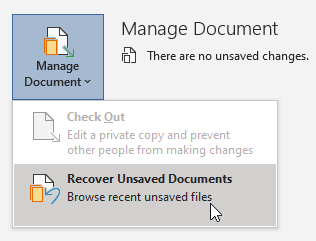
If you're looking for information about how to recover other recent Office files, see the following articles:
If you can't open the document, or the content in the document is damaged, see How to troubleshoot damaged documents in Word.
To find a lost document:
If you have a Microsoft 365 subscription, check the following folder locations for backup files:
Note: In these paths, replace with your username.
If you don't find the missing file in these locations, open Word, and select File > Info > Manage Document > Recover Unsaved Documents.

If you still haven’t found the file, try manually searching for AutoRecover files. To do this, select Start, enter .asd in the Search box, then press Enter.
If you find any files that have the .asd extension, follow these steps:
If there are no .asd files, go to the next method.
Try searching for the document in Windows:
If the search results don't contain the file, go to the next method.
Word backup file names have a ".wbk" extension. If you have the "backup copy" option selected in Word, there might be a backup copy of the file.
To check whether this option is on, select File > Options > Advanced, scroll down to the Save section, and then select Always create backup copy.
If you have a Microsoft 365 subscription, check these two folder locations for a backup file:
Note: In these paths, replace with your username.
To find the backup copy of the file, select Start, enter .wbk in the Search box, and then press Enter. If you find any files that have the name "Backup of" followed by the name of the missing file, double-click the file name to open it.
If you don’t find a backup file for the document, go to the next method.
If you deleted a Word document without emptying the Recycle Bin, you might be able to restore the document.
If you don't find the desired file, go to the next method.
Windows File Recovery Tool
If you are using Windows 10, version 2004 or later, you can try the Windows File Recovery tool. Windows File Recovery is available from the Microsoft Store. You can use it to recover files that have been permanently deleted. For more information about this tool, see Recover lost files on Windows 10.
Restoring documents saved to SharePoint and OneDrive
For documents that you saved or synced to OneDrive, see Restore deleted files or folders in OneDrive.
To find missing content or a newer version:
Word takes different actions to protect your changes in Word documents:


Word searches for AutoRecover files every time it starts. Therefore, you can try using the AutoRecover feature by closing and reopening Word. If Word finds any automatically recovered file, the Document Recovery task pane opens, and the missing document should be listed as "document name [Original]" or as "document name [Recovered]." If this occurs, double-click the file name in the Document Recovery pane, select File > Save as, and then save the document as a .docx file. To manually change the extension to .docx, right-click the file, and select Rename.

Note: In Microsoft 365 Subscription, when Word starts, it searches for AutoRecover files. If any recovered files are found, Word opens them by having a Message Bar. Select Save to save the recovered file as a .docx file. If there are many recovered files, Word usually opens the last-changed files, and puts the remaining files into the Document Recovery task pane.
Temporary file names have a .tmp extension. To find these files, follow these steps:
References